FORSEEING THE UNSEEN - Utility Billing and Payments in the Age of Digital Customer Experiences
For utilities of all sizes today, powerful forces are at work. The expectations of utility customers are rising fast. They want lightning-fast information and services, as well as highly personalized experiences. At the same time, rapid changes are taking place across the entire billing & payment practices displacing the traditional business models. It’s time to forget the wires and connect the wallets - Putting “EXPERIENCE” at the heart of billing and payments journey.
In this blog, we have identified 10 key themes emerging from the rapidly changing digital payments landscape, the differentiated user experience they bring and their implications for utility industry.
The Digital Advantage
With the move to digital, utility services can be available to customers on a 24/7 basis, all year round, offering speedy, secure payments with decreased load time. The shift to digital provides the benefit of superior payment management, maintaining digital records of transactions, and using the data to engage with the customers intelligently. Utilities also have the opportunity to introduce unique payment plans, such as low-income credit plans, automatic payments, payment extensions, and level pay, that consumers can easily avail of through digital channels.
Optimizing the Revenue Cycle
Utilities prodigiously expressed a preference for online payments based on the productivity enhancements they offer. Compared with checks delivered by mail or in person, online payments reduce accounting errors, enable faster posting, and accelerate accounting processes overall.
Enhancing Customer Satisfaction and Increasing Revenue
Digital Payments enhance the customer experience and improve customer satisfaction. Consumers are expressing a clear interest in paying utility bills via digital channels. Since they find these channels easy, convenient, and secure and help them overcome bill payment challenges, this has resulted in increased revenue through fewer late or missed payments, reductions in the costs associated with shutting off and re-establishing service, and mitigating the need for collections.
The Preference-driven Payment Interaction
Utilities serving diverse geographies with multiple dimensions, including demographics, access to online services, and digital savviness, should accommodate various payment channels and methods.
Some consumers prefer to pay their bills in person with cash; others prefer to pay by paper check or by using their bank’s bill-pay interface; most said they prefer to use the biller’s website or app.
Educating customers about online capabilities
The optimal business strategy for utilities includes educating customers and moving them through a continuum of online capabilities. This could start with online payment and progressing, moving on to electronic billing, paperless billing, level pay, auto-payment, and digital self-care. By utilizing customer segmentation, research, and analytical support, utility companies can run focused marketing campaigns to drive these initiatives. For example, a local conservation campaign promoting the environmental benefits of going paperless.
Driving intelligent engagements with smart chatbots
With their data-driven, user-centric, and free-flowing approach, chatbots, virtual agents, and voice assistants are being implemented by energy and water providers in their customer service centers to improve customer engagement while lowering service delivery costs. The use case for digital assistants is not limited to simple Q&As, but also in guiding customers on smarter usage and cost-cutting recommendations, onboarding customers for their first digital transaction, and running retention campaigns to reduce customer churn.
Ensuring payment flexibility with customized payment arrangements
Utility payment plans let customers pay their bills in ways that work for their schedules and budgets. Allowing customers to register for flexible payment options can check all checkboxes for customer control and convenience, substantially improving customer service. While some customers might like to enroll in auto-payments every month using a stored payment method, others might prefer to make partial payments toward their utility bills. Utilities can provide customized payment plans and offers based on the preferences of the customers. This also presents utility providers with the opportunity to provide special credits and rate plans to low-income customers.
Role of personalization in utility billing
Utility bills and statements provide a unique opportunity for energy providers to communicate with their audience, from providing account and payment due information to including relevant offers and important announcements. Utilities can maximize billing experience with strategic communication efforts personalized to the customer needs and billing channel preferences to increase customer satisfaction and enable faster remittance. It presents an opportunity to elevate customer engagement by tailoring the experience based on the customer's individual requirements and promoting additional services, programs, news, and announcements.
The AI/ML revolution
The application of AI and ML in payments is incredibly exciting. From changing customer energy usage patterns for financial savings to making the credit process more accessible, AI/ML applications are un-layering their potential in the energy and utility industry.

The promise of security and compliance
A utility’s billing and payment engine ties the platform, customers, and payments together. With sensitive information about business processes, revenue and personal details of end-users flowing through, utility providers need to ensure that the security of the billing and payment systems is watertight. Given the frequency and scale of cyberattacks worldwide, utilities owe their customers the promise that their data will never be shared without their consent and will be handled safety. This adherence to security and compliance should stem from the very system that handles the payment, billing, and customer data and should provide highest level of security with complete encryption and multi-layer fraud prevention.

Looking ahead
Utilities require technically innovative partners to help them meet current expectations and prepare for future shifts in consumer behavior. Since payment methods are constantly evolving, utilities should also focus on payment service providers for onboarding payment methods consumers prefer. Additionally, they should partner with payment solution providers that understand their unique environments and requirements, and customers and have the technology to meet those needs and keep up with change.




